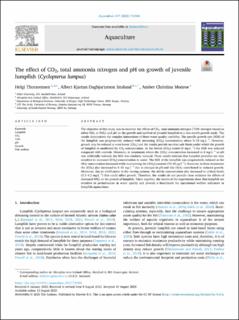The effect of CO2, total ammonia nitrogen and pH on growth of juvenile lumpfish (Cyclopterus lumpus)
Journal article, Peer reviewed
Published version

View/
Date
2023Metadata
Show full item recordCollections
- Department of Biological Sciences [2216]
- Registrations from Cristin [9489]
Abstract
The objective of this study was to examine the effects of CO2, total ammonia nitrogen (TAN: nitrogen bound as either NH3 or NH4+) and pH on the growth and survival of juvenile lumpfish in a two-month growth study. The results demonstrate the complex interactions of these water quality variables. The specific growth rate (SGR) of the lumpfish was progressively reduced with increasing [CO2] concentration above 5–10 mg·L−1. However, growth may be reduced at even lower [CO2] and the results provide no clear safe limits under which the growth of lumpfish is unaffected by CO2 concentration. At the lowest [CO2] tested (8 mg·L−1) the SGR was reduced compared with controls. Moreover, in treatments where the [CO2] concentration increased to 8 mg·L−1 as pH was artificially reduced, the SGR was similarly reduced. These results indicate that lumpfish juveniles are very sensitive to increased [CO2] concentration in water. The SGR of the lumpfish was progressively reduced as the NH4+ concentration increased while maintaining the [NH3] constant (70–80 μg·l−1). However, in these treatments the [CO2] also increased to 8–10 mg·L−1 due to changes in pH and this likely contributed to reduced growth. Moreover, due to nitrification in the rearing systems, the nitrite concentration also increased to critical levels (1.5–4.2 mg·L−1) that could affect growth. Therefore, the results do not provide clear evidence for effects of increased NH4+ on the growth of lumpfish. Taken together, the results of the experiments show that lumpfish are sensitive to perturbations in water quality and provide a benchmark for operational welfare indicators in lumpfish aquaculture.
